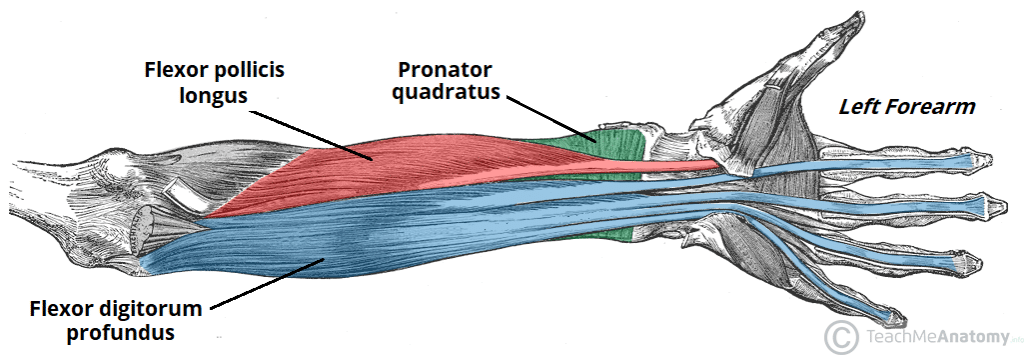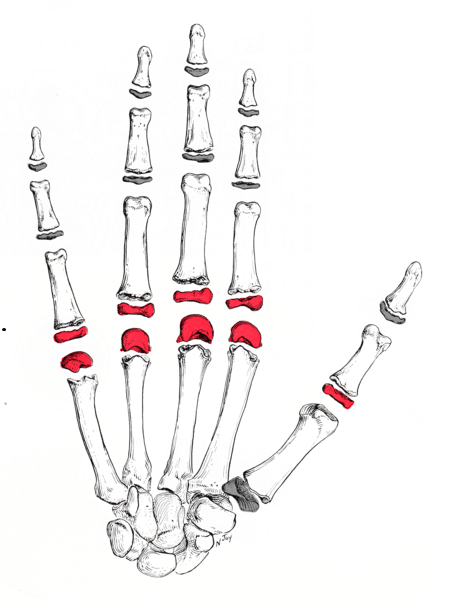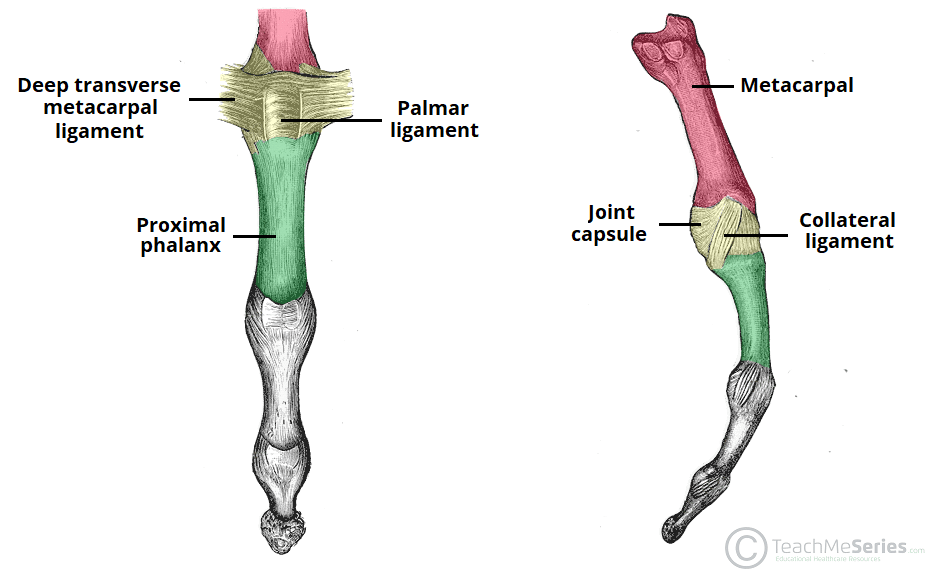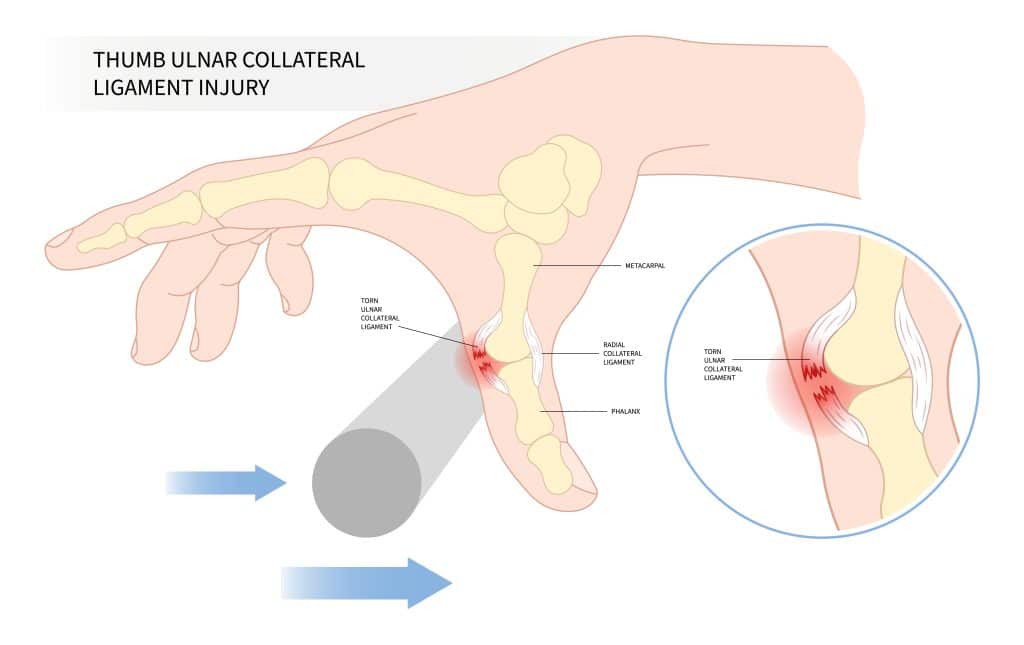The metacarpophalangeal joint is an articulation between the metacarpal head and the base of the proximal phalanx.
There are five joints located in each hand – one for each digit.
In this article, we shall look at the anatomy of the metacarpophalangeal joint – its articulating surfaces, ligaments and clinical correlations.
Anatomical Structure
The metacarpophalangeal (MCP) joint is classified as a condyloid synovial joint. It connects each digit to the palm.
Articulating Surfaces
The metacarpophalangeal joint consists of an articulation between two bones of the hand:
- Metacarpal head – large articulating surface, convex shape.
- Base of proximal phalanx – smaller articulating surface, concave shape.
Both the metacarpal and phalangeal articular surfaces are lined by hyaline cartilage.
Joint Capsule
Each metacarpophalangeal joint is covered by a loose fibrous joint capsule that attaches close to the margins of the articulating surfaces.
The joint capsule is thicker on the medial and lateral aspects – where it is reinforced by collateral ligaments.
Ligaments
The metacarpophalangeal joint capsule is reinforced by several ligaments and adjacent musculoskeletal structures.
The medial and lateral aspects of the joint capsule are reinforced by proper and accessory collateral metacarpophalangeal ligaments.
The anterior aspect of the joint capsule is reinforced by the palmar ligament, a dense fibrocartilaginous thickening that strongly adheres to the palmar surface of the base of each proximal phalanx. The palmar ligament blends on its sides with the collateral ligaments.
The palmar ligaments of the 2nd-5th MCPJs are connected by the deep transverse metacarpal ligaments. These link the digits together, increasing stability.
The posterior aspect of the joint capsule receives fibres from the overlying tendons of the extensor muscles of the forearm (extensor pollicis longus, extensor indicis, extensor digitorum, and extensor digiti minimi).
Movements
Each metacarpophalangeal joint has two planes of motion. It allows for flexion, extension, abduction, adduction, circumduction and limited rotation of the digit.
All of the movements at the joint are produced by muscles of the forearm and hand.
Thumb
- Flexion – produced by flexor pollicis brevis and longus.
- Extension – produced by extensor pollicis brevis and longus.
- Adduction – produced by adductor pollicis.
- Abduction – produced by abductor pollicis longus and brevis.
- Axial rotation – produced by simultaneous contraction of the flexor pollicis brevis and abductor pollicis brevis.
Digits 2-5
- Flexion – produced by flexor digitorum superficialis, flexor digitorum profundus, lumbricals, flexor digiti minimi (5th digit).
- Extension – produced by extensor digitorum, extensor indicis (2nd digit), and extensor digiti minimi (5th digit).
- Adduction – produced by palmar interossei muscles.
- Abduction – produced by the dorsal interossei muscles. Abduction of the fifth digit is also produced by the abductor digiti minimi.

Fig 3 – The flexor digitorum profundus and flexor pollicis longus produce flexion at the MCPJs
Mobility and Stability
The major stabilisers of the metacarpophalangeal joint are the collateral ligaments. The proper collateral ligaments primarily limit hyperflexion, while the accessory collateral ligaments limit hyperextension.
The main function of the palmar ligament is to prevent hyperextension. The deep transverse metacarpal ligaments contribute to MCPJ stability during grip functions.
Blood Supply
The arterial supply to the metacarpophalangeal joints are provided by the following branches of the radial and ulnar arteries:
- Princeps pollicis artery (supplies the MCPJ of the thumb)
- Palmar and dorsal metacarpal arteries
- Radialis indicis artery (supplies the MCPJ of the index finger)
- Common palmar digital arteries
Innervation
The metacarpophalangeal joints are innervated by the posterior interosseus nerve (branch of the radial nerve), deep terminal branches of the ulnar nerve, and palmar branches of the median nerve.
Clinical Relevance: Metacarpophalangeal Joint
Skier’s Thumb
Skier’s thumb refers to an injury of the ulnar (medial) collateral ligament of the 1st metacarpophalangeal joint. It typically occurs when the thumb is forcibly abducted.
It is most commonly seen among skiers that fall on an outstretched arm while holding a ski pole – as holding a ski pole forces the thumb to remain in an abducted position. It is diagnosed with a combination of:
- Physical examination – assessing for joint laxity on abduction
- Ultrasound – assessing for integrity of the ulnar collateral ligament
Severe injuries such as complete ligamentous rupture or displaced bony avulsion fractures require surgical repair.


